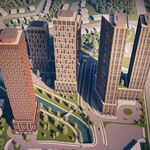MrGoose
Active Member
From @HeronKhalil on Xitter


This proposal would be better if both the Eglinton Crosstown and Finch West lines used the same trains and signal system. Unfortunately there is no interoperability between the Eglinton and Finch West line. Both use different trains and apparently the signal system and electrical currents that each line runs on are different. I complained about this earlier. Metrolinx is creating a bunch of transit lines each with their own type of rolling stock. No attempts at standardisation.
The signal system is different, but the line voltage is the same. If the Eglinton and Finch lines were connected together, the only physical difficulties would be the different signal system.Both use different trains and apparently the signal system and electrical currents that each line runs on are different. I complained about this earlier. Metrolinx is creating a bunch of transit lines each with their own type of rolling stock. No attempts at standardisation.
100% onboard for the subway side of this, but I'm somewhat tenuous about the realignment of LRT to Finch...
View attachment 529113
this isn't exactly a transit fantasy map, but its an idea i've been thinking about for a while. when talking about go electrification/RER and intensification of the downtown core, i can't help but think of the massive potential for redevelopment at the No Frills site on Dundas West. barring some random restriction i'm unaware of, this site would be perfect for a GO station in the future, potentially titled Sterling Station. this station would sit on both the Barrie and Kitchener lines, allowing not only for transfer between these two services but also access to transit to a neighbourhood that today is a bit hard to reach.
in my very rudimentary map, i have included a relocation of the No Frills to the south side of that lot (in yellow, with mid-high rise mixed-use TOD on top). my idea is that once the new No Frills is ready (with a new station mouth, indicated in blue), demolition of the old structure can begin so it could be transformed into a new park (in green) and more TOD mixed-use in magenta. there would also be station boxes/entrances from Wabash Avenue (through a short bridge), Dundas West at Sterling, and Sorauren park through a longer bridge.
i think that once GO RER starts becoming more of a thing we need to think at which sites near GO lines in the city are being underutilized so they can be redeveloped into mixed use transit nodes.
excited to hear some feedback!
Here's an updated version of my concept of introducing a "Regional Express" service type to serve longer-distance trips in the GO Network.
View attachment 530730
PNG version here; PDF version here;
Regional Express trains would use our existing diesel locomotives and BiLevel coaches, but the coaches would be renovated to be more suitable for long distance travel. Train lengths would be limited to at most 8 coaches (typically 6) to ensure that trains can accelerate relatively quickly and reach their 150 km/h top speed, as well as reducing the required size of platforms outside of the core network. This would also help limit surge loads which currently overwhelm stations such as Niagara Falls. Changes to the coaches would include: more comfortable seats, arranging the upper level with airline-style row seating to increase legroom and enable seatback traytables, and providing charging ports at each seat. There would be no difference in fare collection or ticketing. You'd still just tap on and tap off at the standard Presto rate, and there would still not be any reserved seating. To reflect the improved long-distance service offerings, the fare system would become a bit more distance-based, with a lower flat fare and higher zone fares than today.
RE1 is basically just the continued evolution of the existing off-peak Niagara service. Tracks would be upgraded between Hamilton and Niagara to reinstate double-track and increase track speeds. There is one train per hour across the Welland Canal lift bridge, with both directions crossing simultaneously to minimize impact on shipping. There is also one train per hour from Hamilton Centre to Toronto, providing a half-hourly RE service along the LSW corridor.
RE3 is similar to the former London pilot service, but with tracks upgraded to enable a 2h30 travel time from London to Toronto, and trains every hour.
RE9 would be GO taking over the Kingston commuter service that VIA used to operate prior to the pandemic but seems to have abandoned. Initially there would only be two trains in the peak period and one train off-peak, but when many VIA trains shift to a new HFR/HSR line, service can be expanded. GO would be the sole operator at Port Hope, Trenton Junction and Napanee stations, while the remainder continue to be shared with VIA.
There is no "RE program", the program is "GO Expansion". RE is just the term used for the fastest tier of GO express trains. All lines would receive straightened tracks, improved line speeds and expanded capacity. The RE coaches themselves could also be used on some longer-distance Regional services such as those to Kitchener or Barrie. After all we're just talking about a renovation of our abundant Bombardier BiLevel coaches.At the risk of asking something completely obvious, why the choice to omit Barrie from the RE program?
I consider the run time on that line {end to end) unreasonably long; while I think realignment of some of the track in the central reaches to straighten and increase track speeds would be ideal, express trains could help cut that time as well.
The through-running airport tunnel is a totally optional element of this vision. It works just as well with separate branches to Pearson and to Bramalea. However it's worth noting that it does not hurt Brampton riders at all, since the trains from Brampton Centre don't go through that tunnel to begin with. They actually benefit through a faster connection to the airport by transferring at Bramalea than if they needed to go to Pearson Junction and backtrack.I'm doubtful of the value proposition of through running airport trains. A full through run branch is really very expensive... and while a new chord should be much more reasonable that out and back maneuver is going to need a very close examination in terms of how much it hurts Brampton riders. Mind you, crew costs are such that I suspect the actual business case would be "30 minute Regional saves the worst impacted passengers and crew time/total train reductions override the rest"
I didn't show the Brantford line because there wouldn't be spare capacity for it. In this scenario, I assumed that VIA has consolidated all of its service onto the London-Brantford-Toronto corridor with hourly service during busier times of day. Given that it is also still operating as CN's main line, there is little opportunity for reliable GO train service apart from a couple peak period trips. Once the north mainline is upgraded sufficiently that VIA can relocate there, GO could take over the regional-express service via Brantford.Finally I really would push for another RE line going south to London timed to emphasize Brantford passengers. A station for Dundas would be a nice addon here as well.... and I like that if run clockface it would detach the ability to get a consistent 30 minute Lakeshore West REX schedule from canal crossing reliability in Niagara.




